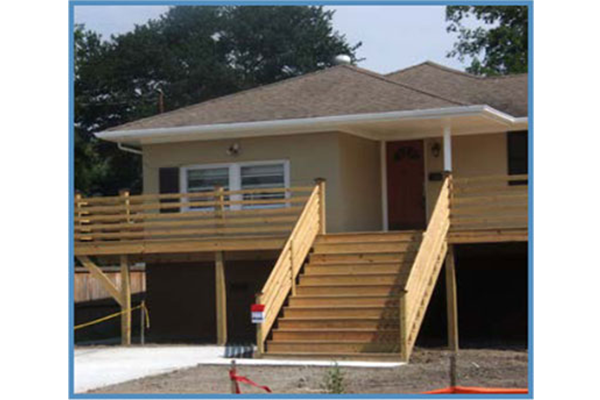
Fig. Housing with raised elevation
(Source: City of Norfolk "Coastal Resilience Strategy")
Climate change impacts
Norfolk, Virginia, USA, is a low-lying coastal city with more than 144 miles of shoreline along lakes, rivers and Chesapeake Bay. While these water resources support the local economy through the naval base, maritime industries, and opportunities for recreation, they are also susceptible to flooding and water-level rise impacts caused by rainfall, storm surges, and extreme weather events like hurricanes. In addition, the frequency and intensity of flooding have been increasing, and is now occurring in areas that had previously been unaffected. In Hague, a neighborhood of Norfolk City, the annual flood duration increased from 50 hours in 1971 to more than 300 hours in 2009.
Adaptation activity
In 2014, Norfolk City announced a "Coastal Resilience Strategy" for coastal flood control that addresses and integrates four areas of concern: ① public policy and effective planning; ② disaster preparedness; ③ the development of mitigation measures; and ④ dialogue between the public and local authorities. In this context, Norfolk’s Department of City Planning, utilized the Virginia Institute of Marine Science's sea-level rise projections to propose changes to flood and coastal ordinances. The main change was to the elevation of all new building construction, for which a "freeboard" of 3 feet (about 90 centimeters) above the flood level mapped by the Federal Emergency Management Agency (FEMA) was prescribed, increasing the previous stipulation of 1 foot (Fig.). Norfolk also considered cumulative damage to existing buildings. New provisions required that buildings meet this "freeboard" requirement in the case that flooding has damaged a building twice, and on each occasion has incurred costs equivalent to more than 25% of the building’s total market value, or if a building’s structure has been damaged of altered.
Outputs / Expected benefits
Norfolk, however, faces obstacles that slow the uptake of revised ordinance and delay adaptation. The density of pre-existing buildings in the city, for example, means that there are only a few new construction projects which are impacted by the new ordinance. Additionally, property owners may have to wait years after buildings have been damaged for FEMA funds to come through, and another issue is that the regulations do not address essential new public infrastructure developments such as sewers and roads.
However, the revised ordinance is only a preliminary measure against flooding issues, and one step towards improving the resilience of the city. Norfolk’s three-foot "freeboard" is considered to be an interim measure, allowing the development of more comprehensive, and larger scale solutions to recurrent flooding in the next 60-65 years.

Fig. Housing with raised elevation
(Source: City of Norfolk "Coastal Resilience Strategy")




